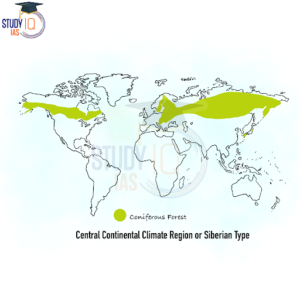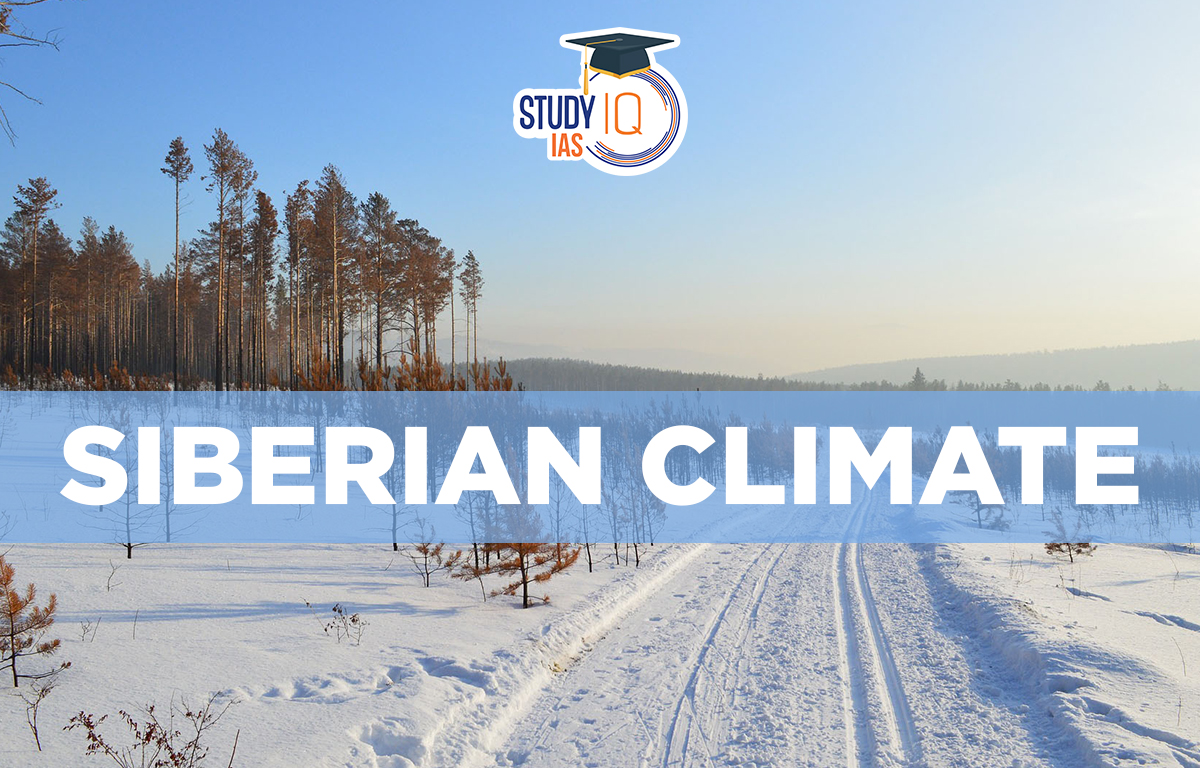Table of Contents
Siberian or Taiga Type Climate
The Siberian climate zone is found at 60 degrees north of the equator. It has long, cold winters and short, warm summers. The Siberian environment rarely sees the spring and fall seasons. The taiga climate is very cold, with little snow and rain and a short growing season. Winters can last up to six months and are very harsh, with average temperatures well below freezing. There are only 50 to 100 days without frost throughout the short summers.
You will learn about the Siberian Climate or Taiga Type of Climate in this article, which will help you with your geography study for the UPSC Civil Service Exam.
Read More: Climatology
Siberian Type Climate
The Siberian-type climate is only found in the Northern Hemisphere because it stretches far east to west. It does not exist in the Southern Hemisphere. This climate is near the areas just south of the Arctic Circle and blends with the Arctic tundra on its northern side. As you move south, the weather changes to a steppe with a milder climate. Boreal Climate, Siberian Climate, Cool Temperate Continental Climate, and Continental Subpolar Climate are other names for it.
Read More: Equatorial Climate Region
Siberian Type Climate Distribution Map
Coniferous forests stretch across central Canada, parts of Scandinavia, and much of central and southern Russia, from 50 to 70 degrees north. They are rare in the Southern Hemisphere because the southern continents are narrow at high latitudes. You can only find them in the rocky uplands of southern Chile, New Zealand, Tasmania, and southeast Australia.
The temperate continental (Siberian) climate is experienced only in the northern hemisphere with the extensive east-west expansion of the continents at high latitudes. It merges around the Arctic Circle on its polar side into the Arctic Tundra of Canada and Eurasia.

The Siberian climate in the southern hemisphere is not pronounced due to the narrowing of the southern continents at high latitudes. Strong sea effects reduce the intensity of winters, and coniferous forests are found only in the mountainous regions of southern Chile, New Zealand, Tasmania, and southeastern Australia.
Read More: Tropical Climate
Siberian Type Climate Temperature
Siberia has short, warm summers with temperatures around 20-25 °C, but winters are long and very cold reaching 30-40 °C below freezing. This area has one of the widest temperature ranges in the world, with differences of 50-60 °C. In places like Verkhoyansk, temperatures can drop to -67 °C. In contrast, North America experiences milder temperature extremes due to its smaller size. Most rivers in Russia freeze, with the Volga River covered in ice for about 150 days each year. Strong cold winds, like the blizzards in Canada and burans in Eurasia, can be very harsh. However, permafrost is usually not found in Siberia because snow acts as an insulator, protecting the ground from the severe cold above.
Read More: Steppe Climate
Siberian Type Climate Precipitation
There is no sign of a maritime effect in the area, but winter can bring some storms. On average, the region gets 38 to 63 cm of rain or snow each year. Most of the summer rain happens in the middle of summer when temperatures are between 15 °C and 24 °C. In winter, it only snows because the temperature stays below zero.
Read More: Precipitation
Siberian Type Climate Natural Vegetation
Landscape features are dominated by evergreen coniferous forests. Conifers flourish in this sub-Arctic environment because they need little rain. Small patches of untouched coniferous forest can be found in Germany, Poland, Switzerland, Austria, and other European nations. In North America, the belt extends from Alaska to Canada and into Labrador.
Read More: Natural Vegetation of India
1. Softwood Trees
The coniferous forest belts of North America and Eurasia are the richest sources of softwood.
Buildings, furniture, matches, paper and pulp, rayon, and other chemical industries all require softwood in their production. The world’s main producers of softwood are Russia, the United States of America, Canada, and the Fennoscandian nations (Finland, Norway and Sweden).
2. Coniferous Forests Characteristics
Contrary to equatorial rain forests, coniferous woods are more consistent and have a moderate density.
Tall, erect trees are produced in coniferous woodlands. Nearly all conifers are evergreen. Unlike deciduous trees, conifers do not regenerate their leaves every year. The lifespan of a single leaf on a tree can reach five years. The bark is thick to protect the trunk from the harsh cold, and the trunks store food. The shape of conifers is conical. Because of its conical shape and slanting branches, snow does not collect.
Additionally, the grip of the winds is weak. Perspiration in hot weather can happen pretty quickly. Leaves have a needle-like shape, are small, thick, and leathery, and prevent excessive transpiration.
Read More: British Type of Climate
Siberian Type Climate Life and Economy
Forests are cleared in areas that are more accessible for logging. The coniferous forest belts in Eurasia and North America are the richest sources of softwood used in construction, furniture, matches, paper, pulp, rayon, etc. The largest softwood producers in the world are Russia, the USA, Canada, and Scandinavian countries (Finland, Norway, and Sweden).
In the newsprint sector, Canada surpasses all other producers, accounting for almost half of the world’s total annual production. There is less agriculture because few crops can survive in the sub-Arctic climate of these northern lands. Many Samoyeds and Yakuts and some Canadians from Siberia are engaged in hunting, trapping and fishing.
Read More: Types of Rainfall
Siberian Type Climate Economic Growth
Many coniferous kinds of wood in the northern hemisphere are still undeveloped because of their isolation. In Canada, Russia, and other countries, coniferous woods are not used as much as they could be. Most logging happens in easier-to-reach forests. In the sub-Arctic, farming is difficult because few crops can survive there.
1.Trapping
The far north of Eurasia and Canada has many animals with thick fur. In very cold areas, the fur gets thicker and better quality, especially during harsh winters. Trappers and hunters in Canada use automatic rifles and live in log homes in coniferous forests to find these animals. The ermine, mink, silver fox, and muskrat are examples of animals that have fur. To ensure a more reliable supply of furs, numerous fur farms have been created in Canada and Siberia.
2. Lumbering
This is the primary occupation of the Siberian climate type. There is a tonne of coniferous woods that support the logging industry.
3. Lumberjacks
In the past, workers called “lumberjacks” would temporarily move to forests to cut down trees. Now, machines do that job. Rivers help transport softwood logs by floating them downstream to sawmills. There, the logs are turned into lumber, plywood, and other building materials.
4. Industry of Paper and Pulp
Timber is pulped chemically and mechanically to produce wood pulp. Paper and newspaper are produced from wood pulp.
Read More: China Type Climate
Siberian Type Climate UPSC
The Taiga is both a breathtakingly gorgeous setting and a crucial ecosystem for the stability and health of the earth. It has adequate moisture to encourage substantial vegetation growth. Above all, it helps to reduce weather extremes and the damage they cause, preserve biodiversity, purify air and water, and maintain a stable climate.
On the other side, the taiga has environmental problems such as excessive clear-cutting of forested regions. Humans work to reconcile the need for resource conservation with the desire to use resources efficiently.


 Story of Meera Bai and Her Devotion For ...
Story of Meera Bai and Her Devotion For ...
 Desert Climate, Distribution, Climatic C...
Desert Climate, Distribution, Climatic C...
 Deserts of India Map, Features of Thar D...
Deserts of India Map, Features of Thar D...





















